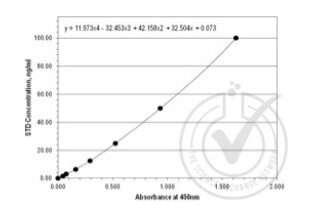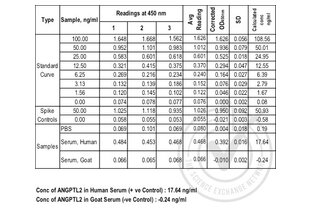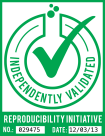ANGPTL2 Kit ELISA
-
- Antigène Voir toutes ANGPTL2 Kits ELISA
- ANGPTL2 (Angiopoietin-Like 2 (ANGPTL2))
-
Reactivité
- Humain
- Méthode de détection
- Colorimetric
- Type de méthode
- Sandwich ELISA
- Gamme de detection
- 1.56-100 ng/mL
- Seuil minimal de détection
- 1.56 ng/mL
- Application
- ELISA
- Fonction
- This assay employs the quantitative sandwich enzyme immunoassay technique.
- Type d'échantillon
- Serum, Plasma, Cell Culture Supernatant, Tissue Homogenate
- Analytical Method
- Quantitative
- Specificité
- This assay has high sensitivity and excellent specificity for detection of Human ANGPTL2.
- Réactivité croisée (Details)
- Limited by current skills and knowledge, it is impossible for us to complete the cross-reactivity detection between the target antigen and all analogues for other species. Therefore, cross reaction may still exist.
- Sensibilité
- 0.39 ng/mL
- Ingrédients
-
- Assay plate (12 × 8 coated Microwells)
- Standard (freeze dried)
- Biotin-antibody (100 × concentrate)
- HRP-avidin (100 × concentrate)
- Biotin-antibody Diluent
- HRP-avidin Diluent
- Sample Diluent
- Wash Buffer (25 × concentrate)
- TMB Substrate
- Stop Solution
- Adhesive Strip (for 96 wells)
- Instruction manual
- Featured
- Discover our best selling ANGPTL2 Kit ELISA
-
-
- Indications d'application
-
- The supplier is only responsible for the kit itself, but not for the samples consumed during the assay. The user should calculate the possible amount of the samples used in the whole test. Please reserve sufficient samples in advance.
- Samples to be used within 5 days may be stored at 2-8°C, otherwise samples must be stored at -20°C (≤ 1 month) or -80°C (≤ 2 months) to avoid loss of bioactivity and contamination.
- Grossly hemolyzed samples are not suitable for use in this assay.
- If the samples are not indicated in the manual, a preliminary experiment to determine the validity of the kit is necessary.
- Please predict the concentration before assaying. If values for these are not within the range of the standard curve, users must determine the optimal sample dilutions for their particular experiments.
- Tissue or cell extraction samples prepared by chemical lysis buffer may cause unexpected ELISA results due to the impacts of certain chemicals.
- Owing to the possibility of mismatching between antigens from another resource and antibodies used in this supplier's kits (e.g., antibody targets conformational epitope rather than linear epitope), some native or recombinant proteins from other manufacturers may not be recognized by this supplier's products.
- Influenced by factors including cell viability, cell number and cell sampling time, samples from cell culture supernatant may not be recognized by the kit.
- Fresh samples without long time storage are recommended for the test. Otherwise, protein degradation and denaturalization may occur in those samples and finally lead to wrong results.
- Commentaires
-
Detection wavelength: 450 nm
Information on standard material:
Depending on the antigen to be detected, standards can be either native or recombinant protein. The recombinant proteins are being expressed in CHO cells in most cases. Please inquire for more information. The formulation of auxiliary material in the standard is considered proprietary information, however it does not contain any poisonous substance. Proclin 300 (1:3000) is used as preservative.
Information on reagents:
In most cases the stop solution provided is 1 N H2SO4. The formulation of wash solution is proprietary information. None of the components contain (sodium) azide, thimerosal, 2-mercaptoethanol (2-ME) or any other poisonous materials. For the sandwich method kits, the sample diluent, antibody diluent, enzyme diluent and standard all contain BSA.
Information on antibodies:
The antibodies provided in different kits vary in regards to clonality and host. Some antibodies are affinity purified, some are Protein A - Volume d'échantillon
- 100 μL
- Durée du test
- 1 - 4.5 h
- Plaque
- Pre-coated
- Protocole
- Antibody specific for ANGPTL2 has been pre-coated onto a microplate. Standards and samples are pipetted into the wells and any ANGPTL2 present is bound by the immobilized antibody. After removing any unbound substances, a biotin-conjugated antibody specific for ANGPTL2 is added to the wells. After washing, avidin conjugated Horseradish Peroxidase (HRP) is added to the wells. Following a wash to remove any unbound avidin-enzyme reagent, a substrate solution is added to the wells and color develops in proportion to the amount of ANGPTL2 bound in the initial step. The color development is stopped and the intensity of the color is measured.
- Préparation des réactifs
-
- Biotin-antibody (1×) - Centrifuge the vial before opening.
Biotin-antibody requires a 100-fold dilution. The suggested dilution is 10µL of Biotin-antibody + 990µL of Biotin-antibody Diluent. - HRP-avidin (1×) - Centrifuge the vial before opening.
HRP-avidin requires a 100-fold dilution. The suggested dilution is 10µL of HRP-avidin + 990µL of HRP-avidin Diluent. - Wash Buffer (1×) - If crystals have formed in the concentrate, warm up to room temperature and mix gently until the crystals have completely dissolved. Dilute 20mL of Wash Buffer Concentrate (25×) into deionized or distilled water to prepare 500mL of Wash Buffer (1×).
- Standard - Centrifuge the standard vial at 6000-10000rpm for 30s.
Reconstitute the Standard with 1ml of Sample Diluent. Do not substitute other diluents. This reconstitution produces a stock solution. Mix the standard to ensure complete reconstitution and allow the standard to sit for a minimum of 15 minutes with gentle agitation prior to making dilutions.
Pipette 250µL of Sample Diluent into each tube. Use the stock solution to produce a 2-fold dilution series. Mix each tube thoroughly before the next transfer. The undiluted Standard serves as the high standard. Sample Diluent serves as the zero standard (0ng/mL).
- Kindly use graduated containers to prepare the reagent. Please don't prepare the reagent directly in the Diluent vials provided in the kit.
- Bring all reagents to room temperature (18-25°C) before use for 30 min.
- Prepare fresh standard for each assay. Use within 4 hours and discard after use.
- Making serial dilution in the wells directly is not permitted.
- Please carefully reconstitute Standards according to the instruction. Avoid foaming and mix gently until the crystals have completely dissolved. To minimize imprecision caused by pipetting, use small volumes and ensure that pipettors are calibrated. It is recommended to suck more than 10µL when pipetting.
- It is recommended to use distilled water to prepare reagents and samples. Using contaminated water or container for reagent preparation will influence detection result.
- Biotin-antibody (1×) - Centrifuge the vial before opening.
- Précision du teste
-
Intra-assay precision (precision within an assay): Three samples of known concentration were tested twenty times on one plate to assess precision.
Inter-assay precision (precision between assays): Three samples of known concentration were tested in twenty assays to assess precision.- Intra-assay: CV% less than 8%
- Inter-assay: CV% less than 10%
- Restrictions
- For Research Use only
-
- by
- Alamo Laboratories Inc
- No.
- #029475
- Date
- 03.12.2013
- Antigène
- Numéro du lot
- T30092379
- Application validée
- ELISA
- Contrôle positif
- Human sera
- Contrôle négative
- Goat Sera
- Conclusion
- Signal was detected in positive control samples but not in negative control samples.
- Anticorps primaire
- Antigen: Angiopoietin-Like 2 (ANGPTL2)
- Catalog Number: ABIN578045
- Lot Number: T30092379
- Anticorps secondaire
- Full Protocol
- All reagents in the ELISA kit were brought up to room temperature (RT) before use.
- 100 µL of standard or sample were added to wells in ELISA plate pre-coated with capture
- antibody. All samples and standards were assayed in triplicate.
- The plate was covered with sealer (provided in kit) and incubated for 2 h at 37°C.
- Unbound material was aspirated and 100 µL of Biotin-Antibody (diluted 1:100 in “Diluent for
- Biotinylated Detection Ab”) was added to each well. Plate was sealed and incubated for 1 h
- at 37°C. Unbound Biotin-Antibody was removed from each well and plate was washed three times with 350 µL of wash buffer (provided in the kit). After the last wash the plate was inverted
- against clean absorbent paper to remove any remaining liquid.
- 100 µL of HRP-Conjugate (1X) was added to each well. Plate was sealed and incubated for 1
- h at 37°C.
- After 1 h incubation at 37°C, unbound HRP-Avidin was removed by washing five times
- with 350 µL of wash buffer (provided in the kit). After the last wash the plate was inverted
- against clean absorbent paper to remove any remaining liquid.
- 90 µL of TMB substrate was added to wells and the plate was covered with a new plate sealer.
- The plate was tapped to ensure mixing and incubated for 25 min at 37°C in the dark.
- After 25 min, when an apparent gradient appeared in the standard wells, the reaction was
- terminated by adding 50 µL of Stop Solution to each well.
- The optical density (OD value) of each well was read using a microplate reader set to 450 nm.
- The triplicate readings for each sample were averaged and the average zero standard optical
- density subtracted to yield ‘corrected absorbance at 450 nm’. A standard curve was generated
- by plotting the mean OD value for each standard on the X-axis against the concentration on
- the Y-axis using Excel. Standard curve was generated by regression analysis with
- four-parameter logistic.
- An equation (y = 11.973x4 - 32.453x3 + 42.158x2 + 32.504x + 0.073) was derived from the
- standard curve and used to calculate Angiopoietin-Like 2 (ANGPTL2) concentrations in
- samples based on their Average Absorbance values.
- Notes
- Nothing to note.
Validation #029475 (ELISA)![Testé avec succès 'Independent Validation' signe]()
![Testé avec succès 'Independent Validation' signe]() Validation Images
Validation Images![Table 1: ELISA. ANGPTL2 is present in Human serum and undetectable in goat serum. Spike controls indicate no interference in absorbance readings from the diluent used to prepare standards and sera samples. Absorbance readings (OD450 nm) are shown for standard curve, spike controls and unknown samples. Value for avg reading is derived from the average reading of three samples. Avg reading for 0 ng/ml Standard was subtracted from all avg readings to yield “Corrected OD450 nm “values for Standards, spike controls and unknown samples. Standard deviation is included for all samples. Standard curve was generated by regression analysis with four-parameter logistic. An equation (y = 11.973x4 - 32.453x3 + 42.158x2 + 32.504x + 0.073 ) was derived from the standard curve and used to calculate ANGPTL2 concentrations shown in the Table 1.]() Table 1: ELISA. ANGPTL2 is present in Human serum and undetectable in goat serum. Spike controls indicate no interference in absorbance readings from the diluent used to prepare standards and sera samples. Absorbance readings (OD450 nm) are shown for standard curve, spike controls and unknown samples. Value for avg reading is derived from the average reading of three samples. Avg reading for 0 ng/ml Standard was subtracted from all avg readings to yield “Corrected OD450 nm “values for Standards, spike controls and unknown samples. Standard deviation is included for all samples. Standard curve was generated by regression analysis with four-parameter logistic. An equation (y = 11.973x4 - 32.453x3 + 42.158x2 + 32.504x + 0.073 ) was derived from the standard curve and used to calculate ANGPTL2 concentrations shown in the Table 1.
Protocole
Table 1: ELISA. ANGPTL2 is present in Human serum and undetectable in goat serum. Spike controls indicate no interference in absorbance readings from the diluent used to prepare standards and sera samples. Absorbance readings (OD450 nm) are shown for standard curve, spike controls and unknown samples. Value for avg reading is derived from the average reading of three samples. Avg reading for 0 ng/ml Standard was subtracted from all avg readings to yield “Corrected OD450 nm “values for Standards, spike controls and unknown samples. Standard deviation is included for all samples. Standard curve was generated by regression analysis with four-parameter logistic. An equation (y = 11.973x4 - 32.453x3 + 42.158x2 + 32.504x + 0.073 ) was derived from the standard curve and used to calculate ANGPTL2 concentrations shown in the Table 1.
Protocole -
- Précaution d'utilisation
- The Stop Solution provided with this kit is an acid solution. Wear eye, hand, face and clothing protection when using this material.
- Conseil sur la manipulation
-
- The kit should not be used beyond the expiration date on the kit label.
- Do not mix or substitute reagents with those from other lots or sources.
- If samples generate values higher than the highest standard, dilute the samples with Sample Diluent and repeat the assay.
- Any variation in Sample Diluent, operator, pipetting technique, washing technique, incubation time/temperature and kit age can cause variation in binding.
- This assay is designed to eliminate interference by soluble receptors, binding proteins and other factors present in biological samples. Until all factors have been tested in the Immunoassay, the possibility of interference cannot be excluded.
- Stock
- 4 °C/-20 °C
- Stockage commentaire
- For unopened kit: All the reagents should be kept according to the labels on vials.
- Date de péremption
- 6 months
-
-
: "Homeobox B9 Mediates Resistance to Anti-VEGF Therapy in Colorectal Cancer Patients." dans: Clinical cancer research : an official journal of the American Association for Cancer Research, Vol. 23, Issue 15, pp. 4312-4322, (2018) (PubMed).
: "Elevated Serum Angiopoietin-like Protein 2 in Patients with Acute Coronary Syndrome." dans: Archives of medical research, Vol. 46, Issue 4, pp. 257-64, (2015) (PubMed).
-
: "Homeobox B9 Mediates Resistance to Anti-VEGF Therapy in Colorectal Cancer Patients." dans: Clinical cancer research : an official journal of the American Association for Cancer Research, Vol. 23, Issue 15, pp. 4312-4322, (2018) (PubMed).
-
- Antigène Voir toutes ANGPTL2 Kits ELISA
- ANGPTL2 (Angiopoietin-Like 2 (ANGPTL2))
- Autre désignation
- angiopoietin-like protein 2 (ANGPTL2) (ANGPTL2 Produits)
- Synonymes
- ARP2 Kit ELISA, HARP Kit ELISA, AI593246 Kit ELISA, AW260363 Kit ELISA, Arp2 Kit ELISA, ANGPTL2 Kit ELISA, angptl2 Kit ELISA, wu:fc41g02 Kit ELISA, arp2 Kit ELISA, fbnl Kit ELISA, harp Kit ELISA, angptl2a Kit ELISA, angiopoietin like 2 Kit ELISA, angiopoietin-like 2 Kit ELISA, angiopoietin-like 2b Kit ELISA, angiopoietin like 2 L homeolog Kit ELISA, ANGPTL2 Kit ELISA, Angptl2 Kit ELISA, angptl2b Kit ELISA, angptl2 Kit ELISA, angptl2.L Kit ELISA
- Sujet
- Synonyms: RP11-1M19.1, ARP2, HARP, MGC8889, angiopoietin-related protein 2
- HGNC
- 490
- UniProt
- Q9UKU9
-



 (2 références)
(2 références) (1 validation)
(1 validation)



